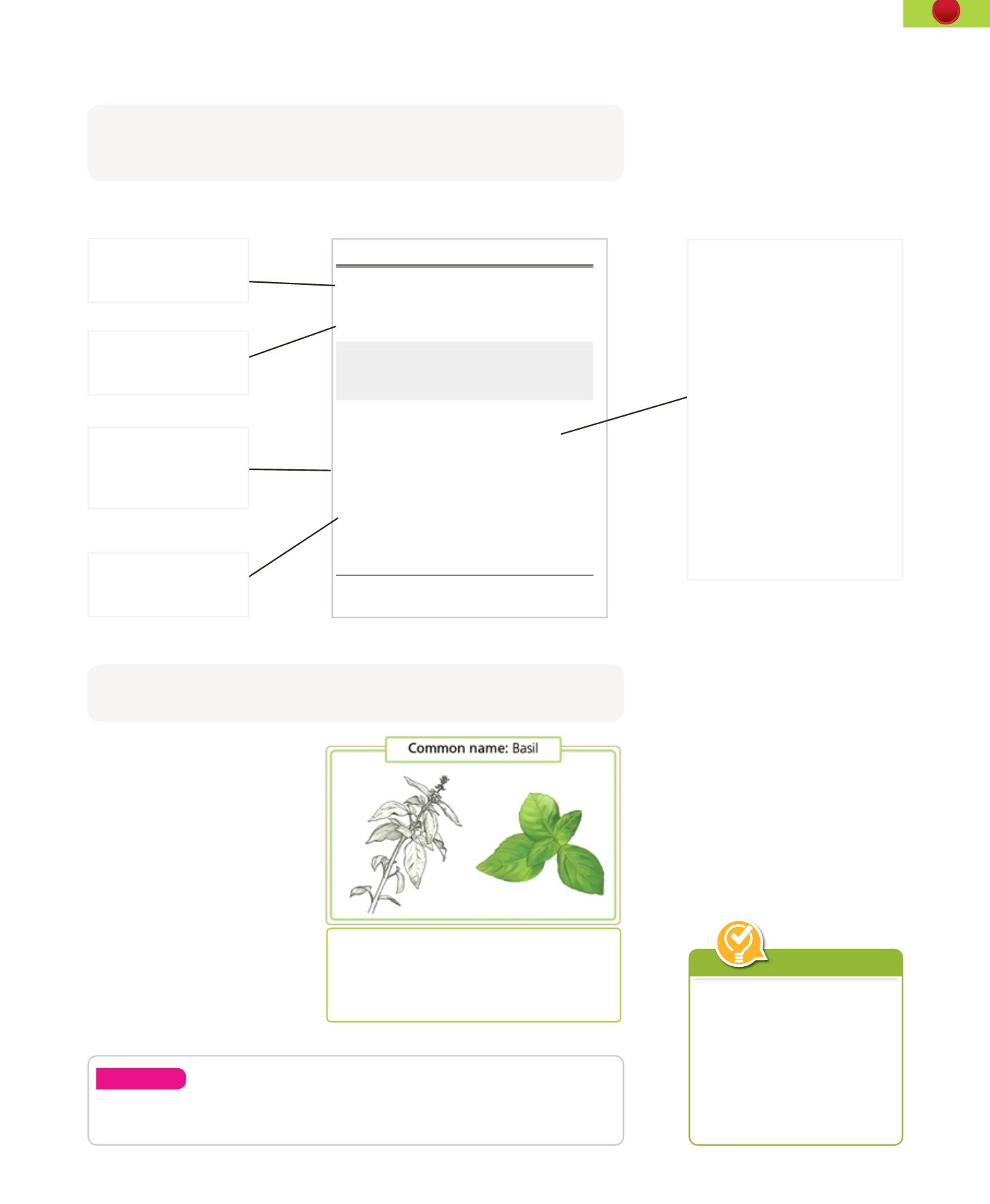
15
1. The scientific method
www
4.3.3.
Scientific articles
A scientific article has different parts:
4.3.4.
Fact sheets
Fact sheets vary depending
on their content. Usually, fact
sheets have a title, an image
and the characteristics of the
object studied. It can also
include details about the work
carried out.
A fact sheet can also contain
a series of questions about a
specific subject in order to give
more general information. An
information leaflet with medicine
is an example of a fact sheet.
A
scientific article
is a piece of writing that is published in a specialised
scientific journal. Scientific articles explain the results of scientific research to
other scientists.
A
fact sheet
is a short document that presents the main characteristics of the
object that is being studied.
Key concepts
❚
A research project follows
the scientific method to
investigate a phenomenon.
❚
The results of a research
project are presented using
posters, oral presentations
with slides, scientific articles
or fact sheets.
ARTICLE
doi:10.1038/nature13793
Artificial sweeteners induce glucose
intolerance by altering the gut microbiota
JothamSuez
1
,TalKorem
2
*
,DavidZeevi
2
*
,GiliZilberman-Schapira
1
*
,ChristophA.Thaiss
1
,OriMaza
1
,DavidIsraeli
3
,
NivZmora
4,5,6
,ShlomitGilad
7
,AdinaWeinberger
2
,YaelKuperman
8
,AlonHarmelin
8
,IlanaKolodkin-Gal
9
,HagitShapiro
1
,
ZamirHalpern
5,6
,EranSegal
2
&EranElinav
1
Non-caloricartificialsweeteners(NAS)areamongthemostwidelyusedfoodadditivesworldwide,regularlyconsumed
byleanandobeseindividualsalike.NASconsumptionisconsideredsafeandbeneficialowingtotheirlowcaloriccontent,
yetsupportingscientificdataremainsparseandcontroversial.Herewedemonstratethatconsumptionofcommonlyused
NASformulationsdrivesthedevelopmentofglucoseintolerancethroughinductionofcompositionalandfunctionalalter-
ationstotheintestinalmicrobiota.TheseNAS-mediateddeleteriousmetaboliceffectsareabrogatedbyantibiotictreatment,
andarefullytransferrabletogerm-freemiceuponfaecaltransplantationofmicrobiotaconfigurationsfromNAS-consuming
mice,orofmicrobiotaanaerobicallyincubatedinthepresenceofNAS.WeidentifyNAS-alteredmicrobialmetabolicpath-
waysthatarelinkedtohostsusceptibilitytometabolicdisease,anddemonstratesimilarNAS-induceddysbiosisandglucose
intoleranceinhealthyhumansubjects.Collectively,ourresultslinkNASconsumption,dysbiosisandmetabolicabnor-
malities,therebycallingforareassessmentofmassiveNASusage.
Non-caloricartificialsweeteners(NAS)wereintroducedoveracentury
agoasmeansforprovidingsweettastetofoodswithouttheassociated
highenergycontentofcaloricsugars.NASconsumptiongainedmuch
popularityowingtotheirreducedcosts,lowcaloricintakeandper-
ceivedhealthbenefitsforweightreductionandnormalizationofblood
sugarlevels
1
.Forthesereasons,NASareincreasinglyintroducedinto
commonlyconsumedfoodssuchasdietsodas,cerealsandsugar-free
desserts,andarebeingrecommendedforweightlossandforindivi-
dualssufferingfromglucoseintoleranceandtype2diabetesmellitus
1
.
SomestudiesshowedbenefitsforNASconsumption
2
andlittleinduc-
tionofaglycaemicresponse
3
,whereasothersdemonstratedassociations
betweenNASconsumptionandweightgain
4
,andincreasedtype2dia-
betesrisk
5
.However,interpretationiscomplicatedbythefactthatNAS
aretypicallyconsumedbyindividualsalreadysufferingfrommetabolic
syndromemanifestations.Despitethesecontroversialdata,theUSFood
andDrugAdministration(FDA)approvedsixNASproductsforusein
theUnitedStates.
MostNASpassthroughthehumangastrointestinaltractwithout
beingdigestedbythehost
6,7
andthusdirectlyencountertheintestinal
microbiota,whichplayscentralrolesinregulatingmultiplephysiolo-
gicalprocesses
8
.Microbiotacomposition
9
andfunction
10
aremodulated
bydietinthehealthy/leanstateaswellasinobesity
11,12
anddiabetes
mellitus
13
,andinturnmicrobiotaalterationshavebeenassociatedwith
propensity tometabolicsyndrome
14
. Here, westudyNAS-mediated
modulationofmicrobiotacompositionandfunction,andtheresultant
effectsonhostglucosemetabolism.
ChronicNASconsumptionexacerbatesglucose
intolerance
TodeterminetheeffectsofNASonglucosehomeostasis,weadded
commercialformulationsofsaccharin,sucraloseoraspartametothe
drinkingwateroflean10-week-oldC57Bl/6mice(ExtendedDataFig.1a).
SinceallthreecommercialNAScomprise
,
5%sweetenerand
,
95%
glucose,weusedascontrolsmicedrinkingonlywaterorwatersupple-
mentedwitheitherglucoseorsucrose.Notably,atweek11,thethree
mousegroupsthatconsumedwater,glucoseandsucrosefeaturedcom-
parableglucosetolerancecurves,whereasallthreeNAS-consumingmouse
groupsdevelopedmarkedglucoseintolerance(
P
,
0.001,Fig.1a,b).
Assaccharinexertedthemostpronouncedeffect,wefurtherstudied
itsroleasaprototypicalartificialsweetener.Tocorroboratethefind-
ingsintheobesitysetup,wefedC57Bl/6miceahigh-fatdiet(HFD,
60%kcalfromfat)whileconsumingeithercommercialsaccharinor
pureglucoseasacontrol(ExtendedDataFig.1b).Asintheleanstate,
micefedHFDandcommercialsaccharindevelopedglucoseintolerance,
comparedtothecontrolmousegroup(
P
,
0.03,Fig.1candExtended
DataFig.2a).Toexaminetheeffectsofpuresaccharinonglucoseintol-
erance,wefollowedacohortof10-week-oldC57Bl/6micefedonHFD
andsupplementedwith0.1mgml
21
ofpuresaccharinaddedtotheir
drinkingwater(ExtendedDataFig.1c).Thisdosecorrespondstothe
FDAacceptabledailyintake(ADI)inhumans(5mgperkg(bodyweight),
adjustedtomouseweights,seeMethods).Aswithcommercialsaccharin,
thislowerdoseofpuresaccharinwasassociatedwithimpairedglucose
tolerance(
P
,
0.0002,Fig.1dandExtendedDataFig.2b)startingas
earlyas5weeksafterHFDinitiation.Similarly,HFD-fedoutbredSwiss
Webstermicesupplementedwithorwithout0.1mgml
21
ofpuresac-
charin(ExtendedDataFig.1d)showedsignificantglucoseintolerance
after5weeksofsaccharinexposureascomparedtocontrols(
P
,
0.03,
ExtendedDataFig.2c,d).
Metabolicprofilingofnormal-chow-orHFD-fedmiceinmetabolic
cages,includingliquidsandchowconsumption,oxygenconsumption,
walkingdistanceandenergyexpenditure,showedsimilarmeasuresbe-
tweenNAS-andcontrol-drinkingmice(ExtendedDataFig.3and4).
*
Theseauthorscontributedequallytothiswork.
1
DepartmentofImmunology,WeizmannInstituteofScience,Rehovot76100,Israel.
2
DepartmentofComputerScienceandAppliedMathematics,WeizmannInstituteofScience,Rehovot76100,Israel.
3
Day
CareUnitandtheLaboratoryofImagingandBrainStimulation,KfarShaulhospital,JerusalemCenterforMentalHealth,Jerusalem91060,Israel.
4
InternalMedicineDepartment,TelAvivSouraskyMedical
Center,TelAviv64239,Israel.
5
ResearchCenterforDigestiveTractandLiverDiseases,TelAvivSouraskyMedicalCenter,SacklerFacultyofMedicine,TelAvivUniversity,TelAviv69978,Israel.
6
DigestiveCenter,
TelAvivSouraskyMedicalCenter,TelAviv64239,Israel.
7
TheNancyandStephenGrandIsraelNationalCenterforPersonalizedMedicine(INCPM),WeizmannInstituteofScience,Rehovot76100,Israel.
8
DepartmentofVeterinaryResources,WeizmannInstituteofScience,Rehovot76100,Israel.
9
DepartmentofMolecularGenetics,WeizmannInstituteofScience,Rehovot76100,Israel.
9 OCTOBER 2014 | VOL 514 | NATURE | 181
MacmillanPublishersLimited.All rights reserved
©
2
0
1
4
The
title
should be brief
and catch the reader’s
attention.
Full names of the
authors
and places of
work.
Key words
help us find
articles because they
relate to the subject of
the article.
A
summary
presents a
condensed description of
the content of the article.
The rest of the article describes the
research:
• The
introduction
explains
the problem studied, previous
investigations, the questions
explored and the hypothesis.
• The
methodology
explains the
steps followed and a description
of the experiments.
• The
results
are presented using
clear language, supported by
graphs, illustrations or other
images.
• The
conclusions
analyse
the results and consider the
objectives and if the hypothesis
is true or not and new lines of
investigation are suggested.
Scientific name:
Ocimum basilicum
Habitat:
gardens
Uses:
food condiment
Characteristics:
annual herb, cultivated as a low height
evergreen (between 30-130 cm), with opposing bright green
leaves with a silky texture (length 3-11 cm; width 1-6 cm)
Analyse
13.
What type of presentation would you use to present the results of your
research to your classmates? Explain your answer.


